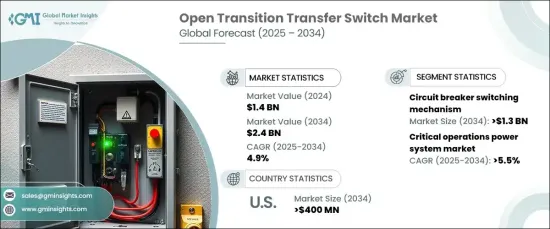
2024년 14억 달러로 평가된 오픈 트랜지션 전환 스위치 세계 시장은 2025년부터 2034년까지 4.9%의 CAGR로 성장할 것으로 예상됩니다.
이러한 성장의 배경에는 주거용, 상업용, 산업용 애플리케이션에서 신뢰할 수 있는 전원 백업 시스템에 대한 요구가 증가하고 있습니다. 안전, 효율성, 규제 기준 준수에 대한 관심이 높아지면서 기술 혁신이 지속적으로 촉진되고 있습니다. 재생에너지의 통합을 촉진하는 정부의 노력은 업계에 새로운 길을 열어주고 있습니다. 자동화 및 연결 기술의 발전으로 원활한 전환과 실시간 원격 모니터링이 가능해져 시장 제공이 크게 개선되었습니다.

이러한 시스템에 스마트 기술을 통합하여 현대의 에너지 문제를 해결함으로써 산업을 변화시키고 있습니다. 전력 변동성을 감지하고 대응하도록 설계된 자동화 솔루션이 확산되면서 성능과 신뢰성이 향상되고 있습니다. 소비자 맞춤형에 대한 기대치가 높아지고 엄격한 안전 표준을 준수해야 하는 상황에서 제조업체들은 진화하는 수요에 맞춰 견고하고 효율적인 설계를 구현하는 데 주력하고 있습니다. 이러한 발전은 지속가능하고 탄력적인 에너지 인프라로의 광범위한 전환과 맞물려 오픈 트랜지션 전환 스위치를 현대 전력 시스템에 필수적인 구성요소로 자리매김하고 있습니다.
| 시장 범위 | |
|---|---|
| 시작 연도 | 2024년 |
| 예측 연도 | 2025-2034년 |
| 시작 금액 | 14억 달러 |
| 예상 금액 | 24억 달러 |
| CAGR | 4.9% |
회로 차단기 기반 스위칭 메커니즘은 2034년까지 13억 달러를 넘어설 것으로 예상됩니다. 더 높은 고장 전류를 처리하고 우수한 보호 기능을 제공할 수 있기 때문에 많은 응용 분야에서 선호되고 있습니다. 또한, 자동화 및 지능형 제어의 도입이 증가함에 따라 이러한 시스템의 기능이 강화되고 채택이 더욱 확대되고 있습니다. 제조업체들은 지속적으로 기술 혁신에 초점을 맞추고 운영 효율성과 신뢰성을 최우선으로 하는 솔루션을 제공함으로써 경쟁하고 있습니다.
미국은 2034년까지 4억 달러 이상의 오픈 트랜지션 전환 스위치 부문이 4억 달러를 넘어설 것으로 예상되며, 앞으로도 이 시장의 주요 기업으로 남을 것으로 보입니다. 전력 신뢰성에 대한 우려가 높아지고 여러 산업 분야에서 백업 전원 시스템에 대한 의존도가 높아지는 것이 이 지역의 주요 촉진요인으로 작용하고 있습니다. 재생에너지, 특히 태양광발전의 보급은 이러한 시스템이 하이브리드 에너지 설정에 원활하게 통합될 수 있기 때문에 수요를 더욱 가속화하고 있습니다. 미국에 본사를 둔 제조업체들은 스마트 에너지 솔루션에 대한 수요 증가에 대응하기 위해 원격 진단 및 모니터링 기능과 같은 첨단 기술을 도입하여 제품의 기능을 향상시키는 데 주력하고 있습니다.
신뢰할 수 있고 효율적이며 지능적인 전력 전송 시스템에 대한 수요가 지속적으로 증가함에 따라 세계 오픈 트랜지션 전환 스위치 시장은 지속적으로 성장하고 있습니다. 혁신, 안전, 지속가능성을 중시하는 이 산업은 현대 에너지 관리 시스템에서 중요한 역할을 담당하고 있습니다.
The Global Open Transition Transfer Switch Market, valued at USD 1.4 billion in 2024, is projected to grow at a CAGR of 4.9% between 2025 and 2034. This growth is fueled by the rising need for dependable power backup systems across residential, commercial, and industrial applications. The increasing emphasis on safety, efficiency, and adherence to regulatory standards continues to encourage innovation. Government initiatives promoting renewable energy integration further open new avenues for the industry. Advancements in automation and connectivity technologies have significantly improved the market's offerings, enabling seamless transitions and real-time remote monitoring.

The integration of smart technologies into these systems is transforming the industry by addressing modern energy challenges. Automated solutions designed to detect and respond to power fluctuations have gained traction, providing enhanced performance and reliability. Growing consumer expectations for customization and the need for compliance with stringent safety standards drive manufacturers to focus on creating robust, efficient designs tailored to evolving demands. These advancements align with the broader shift toward sustainable and resilient energy infrastructure, positioning open transition transfer switches as essential components in contemporary power systems.
| Market Scope | |
|---|---|
| Start Year | 2024 |
| Forecast Year | 2025-2034 |
| Start Value | $1.4 Billion |
| Forecast Value | $2.4 Billion |
| CAGR | 4.9% |
Circuit breaker-based switching mechanisms are expected to exceed USD 1.3 billion by 2034. Their ability to handle higher fault currents and deliver superior protection has made them a preferred choice in many applications. Additionally, the growing incorporation of automation and intelligent controls is enhancing the functionality of these systems, further driving their adoption. Manufacturers continue to compete by focusing on innovation, offering solutions that prioritize operational efficiency and reliability.
The United States is set to remain a key player in the market, with the country's open transition transfer switch sector forecasted to surpass USD 400 million by 2034. Heightened concerns about power reliability and increasing reliance on backup power systems across multiple industries are key drivers in the region. The rise in renewable energy adoption, particularly solar, is further accelerating demand as these systems can seamlessly integrate into hybrid energy setups. US-based manufacturers are concentrating on incorporating cutting-edge technologies such as remote diagnostics and monitoring capabilities to improve product functionality and cater to the growing need for smart energy solutions.
As the demand for reliable, efficient, and intelligent power transfer systems continues to rise, the global open transition transfer switch market is poised for sustained growth. The industry's focus on innovation, safety, and sustainability ensures its role as a critical player in modern energy management systems.